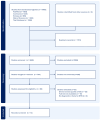Evaluating the Impact of Different Treatments on the Quality of Life in Patients With Burning Mouth Syndrome: A Scoping Review
- PMID: 39473642
- PMCID: PMC11519759
- DOI: 10.7759/cureus.70419
Evaluating the Impact of Different Treatments on the Quality of Life in Patients With Burning Mouth Syndrome: A Scoping Review
Abstract
The profound impact of burning mouth syndrome (BMS) on patients' quality of life (QoL) highlights the critical need to identify effective treatments for this condition. This study aims to evaluate and compare the health-related quality of life (HRQoL) and oral health-related quality of life (OHRQoL) among individuals diagnosed with BMS, focusing on different treatment modalities. For that purpose, a scoping review was designed following the Preferred Reporting Items for Systematic Reviews and Meta-Analyses (PRISMA) for scoping review reporting guidelines and the registration with the International Prospective Register of Systematic Reviews (PROSPERO). An electronic search was then conducted in March 2024, encompassing the following databases: PubMed, Embase, Cochrane, Web of Science, and Trip Database. Publications were deemed eligible if they assessed the impact of different treatments for BMS on health-related and oral health-related QoL. Out of the initial 5400, only 13 studies were considered suitable to be included in this review. The instrument used to evaluate HRQoL was the 36-Item Short Form Survey (SF-36). For OHRQoL, the preferred tools were the Oral Health Impact Profile (OHIP) and the Geriatric Oral Health Assessment Index (GOHAI). Literature reported improvements in patients' HRQoL across the majority of analyzed treatment modalities. However, low-level laser therapy (LLLT) and n-acetylcysteine (NAC) plus clonazepam were the most effective in improving OHRQoL. This review highlights several promising treatment options for improving both HRQoL and OHRQoL in individuals with BMS. Nevertheless, the variability among the studies analyzed underscores the need for further research to identify and establish consistently effective treatments for this condition, reflecting the need for consistent trial designs to accurately assess the true impact of treatments on the disease.
Keywords: burning mouth syndrome; clonazepam; health-related quality of life; low-level laser therapy; oral health; quality of life (qol).
Copyright © 2024, Mendes Abreu et al.
Conflict of interest statement
Conflicts of interest: In compliance with the ICMJE uniform disclosure form, all authors declare the following: Payment/services info: All authors have declared that no financial support was received from any organization for the submitted work. Financial relationships: All authors have declared that they have no financial relationships at present or within the previous three years with any organizations that might have an interest in the submitted work. Other relationships: All authors have declared that there are no other relationships or activities that could appear to have influenced the submitted work.
Figures





Similar articles
-
Effects of low-level laser therapy on burning pain and quality of life in patients with burning mouth syndrome: a systematic review and meta-analysis.BMC Oral Health. 2023 Oct 9;23(1):734. doi: 10.1186/s12903-023-03441-w. BMC Oral Health. 2023. PMID: 37814265 Free PMC article.
-
Assessment of oral health-related quality of life, measured by OHIP-14 and GOHAI, and psychological profiling in burning mouth syndrome: A case-control clinical study.J Oral Rehabil. 2020 Jan;47(1):42-52. doi: 10.1111/joor.12864. Epub 2019 Aug 10. J Oral Rehabil. 2020. PMID: 31332814
-
The future of Cochrane Neonatal.Early Hum Dev. 2020 Nov;150:105191. doi: 10.1016/j.earlhumdev.2020.105191. Epub 2020 Sep 12. Early Hum Dev. 2020. PMID: 33036834
-
The impact on quality of life in patients with burning mouth syndrome: A systematic review and meta-analysis.Oral Surg Oral Med Oral Pathol Oral Radiol. 2021 Feb;131(2):186-194. doi: 10.1016/j.oooo.2020.11.019. Epub 2020 Dec 8. Oral Surg Oral Med Oral Pathol Oral Radiol. 2021. PMID: 33353825
-
Beyond the black stump: rapid reviews of health research issues affecting regional, rural and remote Australia.Med J Aust. 2020 Dec;213 Suppl 11:S3-S32.e1. doi: 10.5694/mja2.50881. Med J Aust. 2020. PMID: 33314144
Cited by
-
Potential Target Receptors for the Pharmacotherapy of Burning Mouth Syndrome.Pharmaceuticals (Basel). 2025 Jun 14;18(6):894. doi: 10.3390/ph18060894. Pharmaceuticals (Basel). 2025. PMID: 40573289 Free PMC article. Review.
References
-
- Treatment modalities for burning mouth syndrome: a systematic review. de Souza IF, Mármora BC, Rados PV, Visioli F. Clin Oral Investig. 2018;22:1893–1905. - PubMed
-
- Burning mouth syndrome: an update. Tan HL, Renton T. Cephalalgia Rep. 2020;3:2515816320970143.
-
- Worldwide prevalence estimates of burning mouth syndrome: a systematic review and meta-analysis. Wu S, Zhang W, Yan J, Noma N, Young A, Yan Z. Oral Dis. 2022;28:1431–1440. - PubMed
Publication types
LinkOut - more resources
Full Text Sources
